
Serpentine Gemstone: Properties, Meanings, Value & More
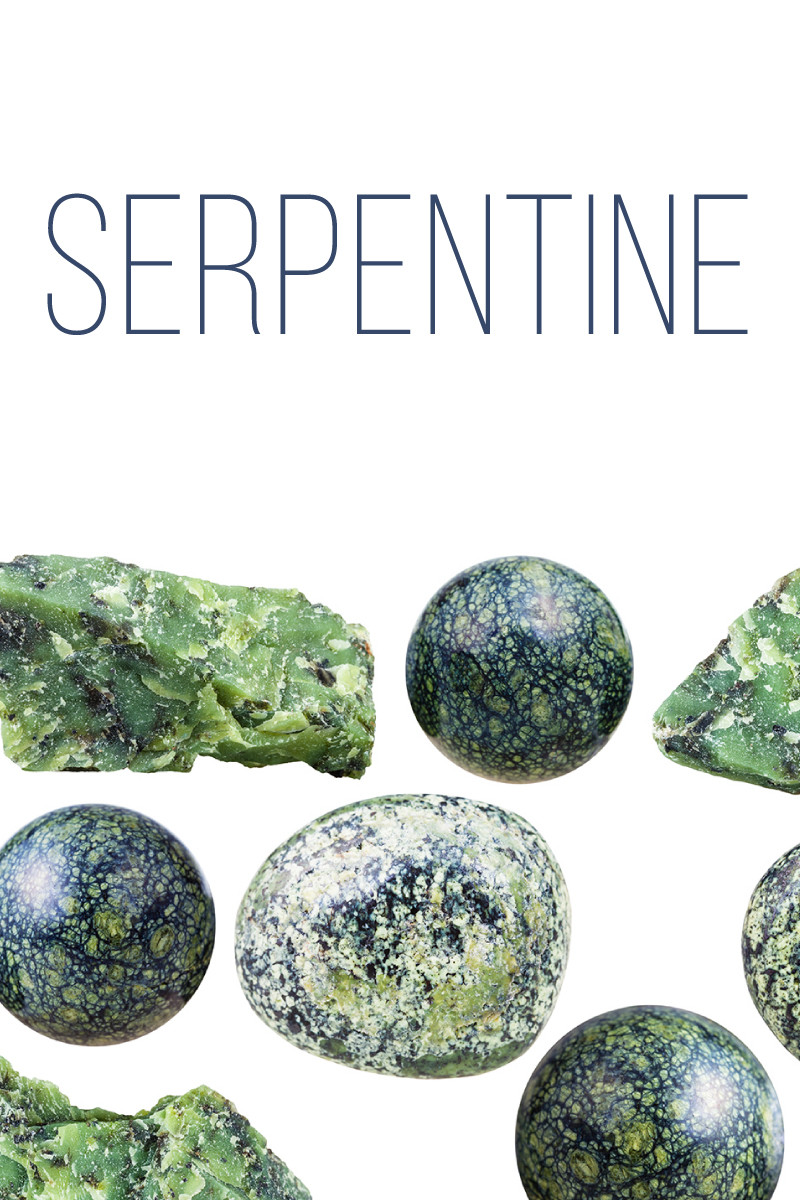 Serpentine is a well-known gemstone in the world of gemology and avid crystal collector circles but tends to be more obscure to the general public. This mostly ornamental gemstone appears in varying shades of green with visually striking veining patterns.
Serpentine is a well-known gemstone in the world of gemology and avid crystal collector circles but tends to be more obscure to the general public. This mostly ornamental gemstone appears in varying shades of green with visually striking veining patterns.
What is serpentine’s name origin? Some say the crystal’s name comes from its unique appearance! Its intricate markings and slippery feel are reminiscent of a serpent. Hence, the name “serpentine!”
Often confused with jade because of their similar likeness, serpentine belongs to an entirely different, unrelated series of minerals.
That’s right — series! Serpentine doesn’t refer to a single mineral but rather a large group of minerals. These serpentine minerals are all related, sharing similar compositions and forming through similar processes.
Curious to learn more about the unique serpentine mineral series? Keep reading to slither into all there is to know about serpentine’s history, meanings, properties, value, and more!

About Serpentine Stone
First, what is serpentine good for? Besides its transformative healing powers (more on that in a bit), serpentine is used in jewelry, architecture, art, and more!
Serpentine’s similarity to jade makes it popular as an affordable jade substitute. Some even call it “new jade” or “snake jade.” However, serpentine is softer than real jade! Some other pseudonyms are “false jade” and “teton jade.”
The official state mineral of California may be gold, but serpentine was awarded the title of official state rock for the Golden State in 1965.
While it’s not an official zodiac stone, serpentine attunes to Gemini signs in astrology. The meaning of serpentine to Geminis is one of grounding. Its spiritual vibrations can help bring balance to Gemini’s conflicting nature.
Next up, serpentine’s mineral traits!

Serpentine Mineral Characteristics
While green serpentine stone tends to be the most common, this semi-precious gemstone also appears in varying yellows, browns, blues, and whites. Most stones display spotty, vein-like inclusions of chromite or magnetite octahedra. Some specimens have so much magnetite that you can move them with a magnet!
Some fibrous varieties (like chrysotile) can resist heat transfer, combat burning, and act as ideal heat insulators in an industrial capacity.
Though properties can vary among different serpentine minerals, here is an overview of generalized serpentine properties:
Chemical Formula: (Mg,Fe,Ni)3Si2O5(OH)4
Composition: Silicate
Mohs hardness: Between 3 to 5, but varies
Color: Varying shades of green, yellow, black, white, and other colors
Crystal structure: Monoclinic; microcrystalline
Luster: Waxy, Resinous, Greasy, Silky, Dull
Transparency: Translucent to opaque, rarely transparent
Refractive index: 1.56 to 1.57
Density: 2.5 to 2.6
Cleavage: Poor to perfect; Sometimes none
Fracture: Granular, uneven
Streak: White
Luminescence: Fluorescent; Inert to weak blue in SW-UV, Inert to weak green in LW-UV

Types of Serpentine
While serpentine subgroups share similar compositions, their properties have some variations. They usually occur mixed as rocks. When cut, they’re all described as “serpentine,” but they differ in various ways.
Antigorite
Antigorite is the most commonly faceted variation. It’s more of a yellow serpentine than a green type and occurs on every continent, including Antarctica.
Bowenite
Bowenite is a translucent variety of antigorite and commonly appears in blue-green, yellow-green, or dark green shades. It’s also the hardest of the serpentines. Notable deposits have been found in Afghanistan, China, New Zealand, South Africa, and the United States.
Chrysotile
Chrysotile is a fibrous variety and a source of asbestos found worldwide. It can appear in white, gray, yellow, brown, and green.
Healerite
Healerite, or noble serpentine, is soft lime-green serpentine and a more recently discovered variation. It hails from the Washington State mountains in Northwest USA.
Lizardite
Lizardite is the most common serpentine variety and was named for the Lizard Peninsula in Cornwall, England where it was first discovered. Lizardite joins chrysotile and antigorite as one of the three primary serpentine minerals.
Verd Antique
Found in Egypt, Greece, Italy, and Vermont (USA), verd antique is a green gem rock marbled with serpentine, calcite, dolomite, and magnesite.
Williamsite
Named after its discoverer (Lewis White Williams), williamsite is another translucent variety of antigorite. It’s usually apple-green with dark octahedral chromite crystals and patches of white magnesium hydroxide.
Moving along, let’s take a peek at serpentine’s journey through history!
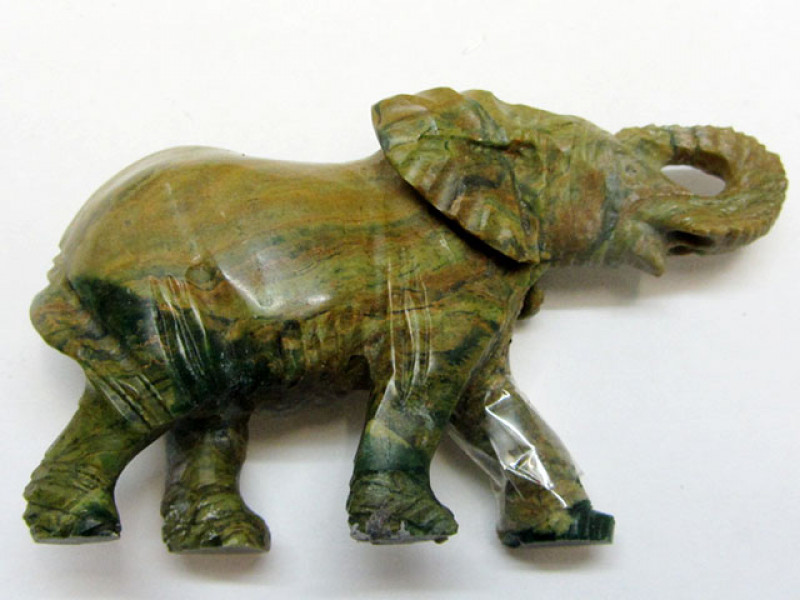
Serpentine Meaning & History
Serpentine was named by German mineralogist Georgius Agricola (Georg Bauer) in 1564. The name derives from Latin serpens (for “serpent”) because of the stone’s mottled green appearance that resembles the skin of a snake.
Serpentine was highly regarded in Ancient Egypt, Persia, and Assyria for its exquisite luster. It was popular in jewelry, household decor, and religious offerings. Serpentine pendants were often worn to fight evil energies and protect against snakebites. Even more popular was its ornamental use in decorative carvings and sculptures.
In the Punjab region of Southeast Asia, serpentine was used to adorn native weaponry. Similarly, the Maori tribes of New Zealand would carve talismans and ornaments from serpentine. It was also highly valued by the Aztec civilization.
Fibrous varieties, like chrysotile, were once used to make asbestos for many industrial uses. However, due to its association with respiratory disease, asbestos has mostly been retired. Today, serpentine is mainly used in jewelry and sculptures.
So, how did serpentine garner the honor of California’s state rock? It earned the distinction not just because of its local abundance and industrial uses but also because of all the good it does for the land.
Serpentine can host rare, unique vegetation. Additionally, it delivers healing to the planet by reducing greenhouse gasses through carbon sequestration. Good-bye, climate crisis — Hello, self-sustaining Mother Earth!
Metaphysically, what does serpentine mean?
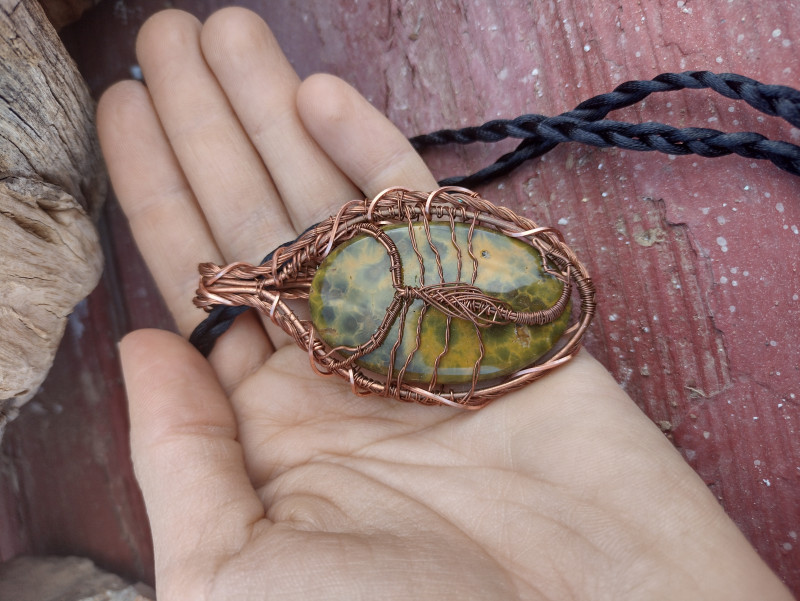
Serpentine Healing Properties
Like most crystals, serpentine’s composition and metaphysical properties make it a potent healing stone.
As with most green crystals, serpentine is an earth-element stone. Its green color is symbolic of prosperity, flourishing, grounding, and Mother Earth.
Keep reading to see how serpentine benefits your mind, body, and spirit!
Physical Healing
In terms of physical healing, serpentine may help alleviate diabetes and hypoglycemia.
Its cleansing energy can be highly detoxifying for the body and blood — helping to rid you of parasites and bugs. It may also help your body absorb calcium and magnesium.
Emotional Healing
For emotional uses, serpentine is a favorite among crystal healers as a symbol of protection. Its association with snakes is said to induce protective energy around the body and spirit — enabling you to pursue achievements you’ve been putting off.
Some say that keeping serpentine close to you helps turn negative thoughts and actions into positive ones.
Chakra Healing
Some gems can help balance the seven chakras (or energy points) along the center of your body. While serpentine can be used as a chakra stone for your entire chakral body, it particularly resonates with the heart chakra.
The heart chakra is associated with love, compassion, and healing. Serpentine can help open the chakra to bring you a sense of calm, peace, and self-love.
Now that you know all about serpentine crystal benefits, let’s look at which properties play into its value!
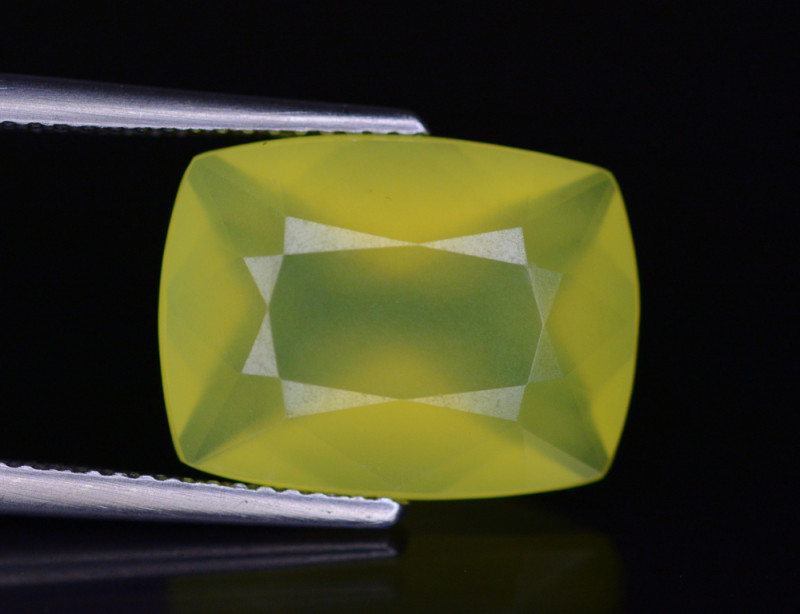
Serpentine Gemstone Properties
Serpentine’s value stems from standard properties like color, cut, clarity, and weight.
Color
Serpentine stones vary in shades of green but sometimes appear in varying hues of white, yellow, gray, brown, or black. Most gems are veiny or spotted and may exhibit areas of chatoyancy (the cat’s eye effect), which can appear light or dark depending on your viewing perspective.
Cut
Although it’s a relatively soft gem, serpentine can be cut into various shapes and used in low-impact jewelry like earrings or pendants. Lapidaries often cut serpentine into cabochons, beads, and decorative carvings. Some varieties (like williamsite) are translucent enough to be faceted.
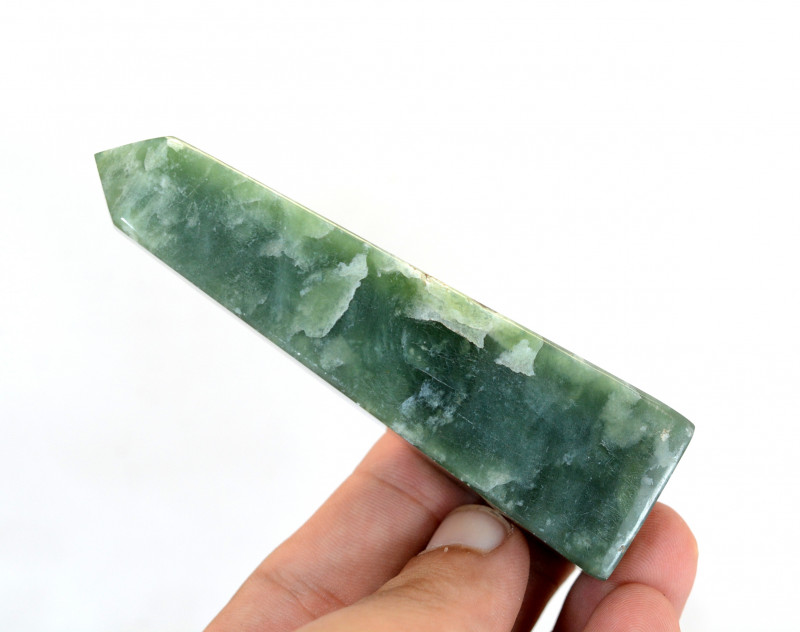
Clarity
Serpentine is generally translucent to opaque and rarely semi-transparent. Most gems contain impurities of calcite and other mineral inclusions. The inclusions produce white or black veining, marbling, or spotting. The more intricate the pattern, the more desirable the gem.
Carat Weight & Size
Serpentine usually always occurs in large formations and is later cut down by lapidaries. In terms of sizing, serpentine gems generally weigh in carats. On the other hand, serpentine carvings and sculptures can vary in measurement and may be sold by dimensions instead of weight.
Treatments
Serpentine stones are subject to a couple of treatments: impregnation with resin (to improve stability) and dye (to improve color).
Green dyes enhance their “jade-like” appearance, but they can also create shades beyond green serpentine’s natural range, like oranges and purples. These dyed specimens can imitate other gems besides jade, such as sugilite.
So how is serpentine formed anyway? Let’s find out!
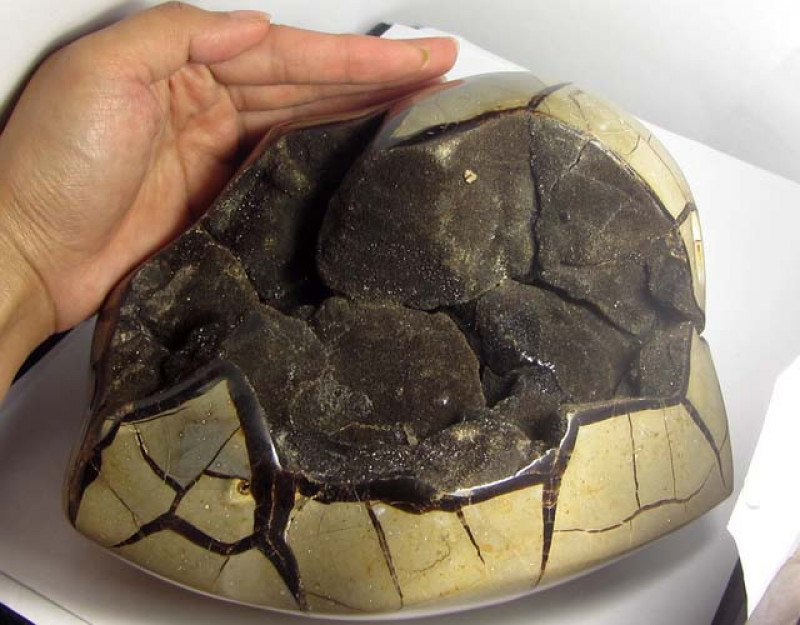
Serpentine Formation & Sources
First, is serpentine rock? Yes! Well, kind of.
Technically, serpentine is the metamorphosed remains of magnesium-rich igneous rocks from Earth's mantle. These ultramafic rocks (commonly peridotite or dunite) undergo hydrothermal metamorphism at convergent plate boundaries.
During this metamorphism, minerals like olivine and pyroxene transform into serpentine minerals. Some of the metamorphic rocks produced, called serpentinites, are composed almost entirely of serpentine minerals.
Much of Earth’s surface is situated just above serpentinites! These areas occur near present or ancient convergent tectonic plate boundaries where remnants of oceanic plates are exposed to the surface. These remnants were either thrust up, grown onto the edge of a landmass or brought up by weathering.
The sites of these exposed oceanic plates (known as ophiolites) are often home to minerals like magnetite, chromite, chrysoprase, jade, and of course, serpentine!
Mining Locations
Where is serpentine found?
Large deposits can be found in Greece, Cyprus, and mountain ranges of Russia, New Zealand, Austria, France, Italy, and the U.S.
Some other notable localities across the world include:
Afghanistan
Australia
Brazil
Canada
China
The Congo
India
Madagascar
Pakistan
South Africa
United Kingdom
Compelled to purchase your own serpentine gems? Here’s what to expect budget-wise!

Serpentine Stone Price & Value
Because serpentine is a common and widely abundant mineral, it’s also fairly affordable.
Smaller gemstones cut into rounded shapes like cabochons can range between $0.20 to $2.74 per carat. Beads can range approximately between $0.07 to $0.26 per carat.
Jewelry prices vary. Rings generally tend to teeter between $36 to $70, but some can fetch prices as high as $136. Beaded bracelets range between $2.50 to $40.
Uncut (or raw) serpentine can fare between $0.41 to $0.89 per carat.
So you’ve finally scored some “snake jade” to add to your crystal collection! Let’s wrap up with some serpentine gemstone care!
Serpentine Care and Maintenance
Serpentine is a soft, delicate mineral — so much so that even household dust particles can cause it to scratch.
Ring stones should implement a protective setting to ensure your gem’s longevity.
To extend your serpentine crystals’ lifespan, avoid:
Harsh chemicals
Perfumes/cosmetics
Ultrasonic cleaners
Steam cleaners
Abrasive minerals
Sudden temperature changes
Wearing during impact-prone activities
For cleaning, use mild soap and water. Gently pat dry with a soft, untreated cloth. Dry thoroughly and store in a protective pouch away from harder gems or impact risk.

Shed the Bad Vibes with Serpentine!
Just as a snake sheds its skin, serpentine helps you shed negative energies and replaces them with fresh, positive vibes to keep you going. Besides its metaphysical abilities, serpentine continues to be a show-stopping feature in artistic sculptures and one-of-a-kind jewelry pieces.
Whether you’re looking to transform your space, spirit, or both, serpentine may just be the obscure crystal you didn’t know you needed!
Search the Gemstone Encyclopedia
Related Auctions
Related Articles
Originally the Birthstones or gemstones were associated with a zodiac sign or the month of a individuals birth. Find out what your stone is and view the stones we have for sale
8th Feb 2021
There are dozens of quartz and chalcedony gems with various colors and patterns. Learn all about quartz properties and every type of quartz, from amethyst and agate to plasma and phantom quartz!
15th Oct 2020
Hackmanite is a pink to violet sodalite gem known for its unique color-change and luminescence. Learn why hackmanite is special, from its rare qualities to the types of hackmanite jewelry available.
28th Mar 2018
Latest Articles
Yugawaralite is a rare colorless, white, or pinkish zeolite crystal named for its discovery in Yugawara, Japan. Here we uncover the multifaceted history, properties, prices, and uses of yugawaralite.
24th Mar 2025
Simpsonite is a lesser-known mineral known on the gem market for its durability, yellow-orange color, and rarity. Discover all the properties, uses, prices, and history of simpsonite.
3rd Mar 2025
Kurnakovite is a colorless crystal related to inderite and rarely faceted but known among collectors. Explore the mineral traits, history, prices, and more in this kurnakovite guide.
17th Feb 2025
Article Categories
How To's is where you will find helpful articles from gem Rock Auctions on how to cut gemstones, select gemstones and buy gemstones.
9 Articles





